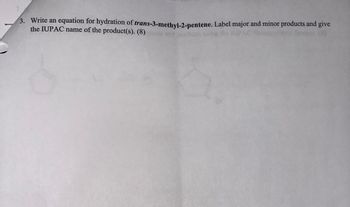Oh no! Our experts couldn't answer your question.
Don't worry! We won't leave you hanging. Plus, we're giving you back one question for the inconvenience.
Submit your question and receive a step-by-step explanation from our experts in as fast as 30 minutes.
You have no more questions left.
Message from our expert:
It looks like you may have submitted a graded question that, per our Honor Code, experts cannot answer. We've credited a question to your account.
Your Question:

Transcribed Image Text:3. Write an equation for hydration of trans-3-methyl-2-pentene. Label major and minor products and give
the IUPAC name of the product(s). (8)
using
Want to see the full answer?
Check out a sample Q&A hereKnowledge Booster
Learn more about
Need a deep-dive on the concept behind this application? Look no further. Learn more about this topic, chemistry and related others by exploring similar questions and additional content below.Similar questions
- 5 moles of ethanol, 6 moles of ethanoic acid, 6 moles of ethyl ethanoate and 4 moles of water were mixed together in a separatory funnel at 15 ° C. After equilibration was established, only 4 moles of ethanoic acid were found in the funnel. a) Write the equation for the reaction between ethanol and ethanoic acid to form ethyl ethanoate and water. b) How many moles of ethanol, ethyl ethanoate and water are present in the equilibrium mixture? d) What is the value of the equilibrium constant for this reaction?arrow_forward1. The acid-catalyzed elimination of an alcohol is an equilibrium reaction and requires special reac- tion conditions to favour the formation of the alkene product. What chemical principle controls the amount of alkene product that is produced? Provide two laboratory techniques that can be used to obtain good alkene yields in alcohol elimination reactions.arrow_forward6. Predict the major organic product for each of the following reactions. Draw the condensed structural formulas for the products. Name the reactants and products (organic compounds only.) If there is no reaction, write NR. If a compound is a hemiacetal or acetal, don't name it – just label it as "hemiacetal" or "acetal." a) Cat. b) OH CH-CH-とH-CHz + PG C Ciy C当 c) CH 188C Ho d) CH3 CH-CH-CH C4-Cち [o] OH e) acid + 0 Caュ-Csarrow_forward
- 1. Consider the solubility and boiling point of the following pair of compounds: n-butyl alcohol and diethyl ether. The boiling points for the compounds are 118 °C and 35 °C respectively. The solubility for both compounds is the same (8g/100g water). Explain this observation for (i) boiling point disparity; (ii) solubility similarity a. H-bonds form in diethyl ether; n-butyl alcohol forms H-bonds in water b. H-bonds form in n-butyl alcohol; diethyl ether forms H-bonds in water c. H-bonds in n-butyl alcohol; Both compounds form H-bonds in water d. Both compounds form H-bonds; Both compounds form H-bonds in water 2. Account for the bond angle differences between (i) H-C-H (109.5°) in methane and H-S-H (90°); H-C-H (109.5°) and H-O-H (107.5°) in water. a. The H-S-H has two lone pairs; The H-O-H has two lone pairs b. The H-S-H has no hybridization at p-orbitals; The H-O-H has two lone pairs c. The H-S-H has two lone pairs; The H-O-H has no hybridization…arrow_forwardUsing the relationship between the structure and the boiling point. Obtain a table for the listed chemicals below showing how the boiling point will be different with (1) the different chemical structures, (2) with different functional groups. Boiling Point and Functionalized Compounds: Chemical: Cyclohexanol Cyclohexanone Cyclohexene Benzaldehyde Benzyl alcoholarrow_forwardPredict the major organic product for the following reactions Draw the condensed structural formulas for the reactants and products and name the products (organic compounds only) If there is no reaction write NR. If a compound is a hemiacetal or acetal, don't name it – just label it as "hemiacetal" or “acctal." a) 2-methyl-3-pentanone + 2-propanol (isopropyl alcohol) b) Product in (a) + 2-butanol c) Complete oxidation of 3,4-dimethyl-1-pentanol (strong oxidizing agent) d) Hydration of 1,3-dimethylcyclopentene ) Intermolecular dehydration of 2-methyl-1-propanol (isobutyl alcohol)arrow_forward
- Draw the structural formula for the major product as the following reactionarrow_forwardComplete the following syntheses – they may be two- or three-step processes. Include any necessary catalysts or reaction conditions. c) Prepare methyl ethanoate from ethanol and methanolarrow_forwardfind out correct and incorrect IUPAC name and give reason behind it!arrow_forward
- What is a balanced equation to form sodium methoxide from methanol? With a reactant that is strong enough to favor products and a proper arrow-pushing formula.arrow_forwardComplete the following syntheses – they may be two- or three-step processes. Include any necessary catalysts or reaction conditions. b) Prepare ethanoic acid from ethenearrow_forwardProvide the IUPAC name and structure of the substitution product(s) which results from the reaction between (2R,3R)-2-chloro-3-methylpentane and hydroxide.arrow_forward
arrow_back_ios
SEE MORE QUESTIONS
arrow_forward_ios
Recommended textbooks for you

 Chemistry for Today: General, Organic, and Bioche...ChemistryISBN:9781305960060Author:Spencer L. Seager, Michael R. Slabaugh, Maren S. HansenPublisher:Cengage Learning
Chemistry for Today: General, Organic, and Bioche...ChemistryISBN:9781305960060Author:Spencer L. Seager, Michael R. Slabaugh, Maren S. HansenPublisher:Cengage Learning Introduction to General, Organic and BiochemistryChemistryISBN:9781285869759Author:Frederick A. Bettelheim, William H. Brown, Mary K. Campbell, Shawn O. Farrell, Omar TorresPublisher:Cengage Learning
Introduction to General, Organic and BiochemistryChemistryISBN:9781285869759Author:Frederick A. Bettelheim, William H. Brown, Mary K. Campbell, Shawn O. Farrell, Omar TorresPublisher:Cengage Learning


Chemistry for Today: General, Organic, and Bioche...
Chemistry
ISBN:9781305960060
Author:Spencer L. Seager, Michael R. Slabaugh, Maren S. Hansen
Publisher:Cengage Learning

Introduction to General, Organic and Biochemistry
Chemistry
ISBN:9781285869759
Author:Frederick A. Bettelheim, William H. Brown, Mary K. Campbell, Shawn O. Farrell, Omar Torres
Publisher:Cengage Learning